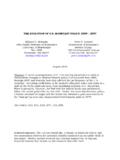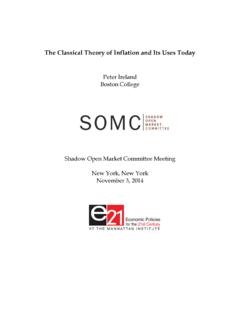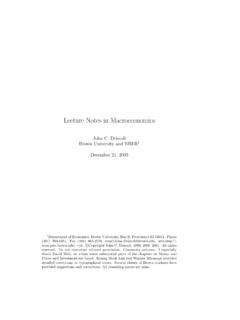Transcription of Lecture Notes on Macroeconomic Principles
1 Copyright (c) 2009 by Peter N. Ireland. Redistribution is permitted for educational and research purposes, so long as no changes are made. All copies much be provided free of charge and must include this copyright notice. Lecture Notes ON Macroeconomic Principles Peter N. Ireland Department of Economics Boston College ~ Ch 23 Measuring a Nation s Income introduction Microeconomics studies how households and firms make decisions and how they interact in markets. macroeconomics studies the economy as a whole. Some questions addressed by macroeconomics : 1. Why is average income high in some countries and low in others? 2. Why do prices rise rapidly in some periods and remain stable in others? 3. Why do production and employment expand in some years and contract in others? 4. What can the government do to promote rapid growth in income, stable prices (low inflation), and high employment?
2 This chapter focuses on gross domestic product or GDP as a measure of economy wide well being. Outline 1. Income and Expenditure 2. Measuring GDP 3. The Components of GDP 4. Real and Nominal GDP 5. GDP and Economic Well Being Income and Expenditure GDP measures two things at once: 1. The total income of everyone in the economy. 2. The total expenditure on the economy s output of goods and services. Why? Because for the economy as a whole, income must equal expenditure. For every buyer there must be a seller. The circular flow diagram (Figure 1) illustrates this: In markets for factors of production (inputs): o Households sell or rent labor, land, and capital. Their income equals GDP. o Firms buy or hire labor, land, and capital. Their wages, rent, and profit equal GDP. In markets for goods and services (outputs): o Firms sell goods and services.
3 Their revenue equals GDP. o Households buy goods and services. Their expenditure equals GDP. 2 This diagram ignores the financial sector, the government, and the foreign sector. Later we will expand our analysis to include them, but without changing this basic result that for the economy as a whole, income must equal expenditure. Measuring GDP GDP is the market value of all final goods and services produced within a country in a given period of time. GDP is the market value .. GDP measures all goods in terms of their market value, in the common unit of dollars. You can t compare apples and oranges. If an apple costs twice as much as an orange, then it contributes twice as much to GDP. Non market activities like leisure, housework, and child care don t contribute to GDP.. of all.
4 That last caveat notwithstanding, GDP tries to be comprehensive.. final .. International Paper makes paper, which is used by Hallmark to make a greeting card. In this example, paper is an intermediate good, since it is used as an input for producing yet another good. The greeting card is a final good, since it is sold to and used by and end user. Since the value of the final good reflects the value of the intermediate good, only the value of the final good is included in GDP to avoid double counting.. goods and services .. Goods include cars, food, clothing, etc. Services include haircuts, medical care, etc.. produced .. GDP only includes newly produced goods. Buy a new car, that contributes to GDP. Buy a used car, that does not contribute to GDP.. within a country .. US GDP counts all goods and services produced in the US.
5 A Canadian works in the US; her income counts in US GDP. A US citizen works in Canada; his income does not count in US GDP. 3 .. in a given period of time. Usually within a quarter (3 months) or a year. The Components of GDP GDP can be decomposed into four components: consumption, investment, government purchases, and net exports. Consumption Consumption is spending by households on: Durable goods (cars, appliances). Nondurable goods (food). Services (haircuts). Investment Investment is spending by firms on goods that will be used in the future to produce more goods and services: Capital equipment (machines and tools). Structures (factories, office buildings). Inventories (goods produced but not yet sold). By convention, the purchase of a newly built house is a form of spending by households that is also included in investment.
6 Note that inventory accumulation is counted as investment: If Ford builds a $50,000 car in 2008, but the car sits in inventory through the end of the year, GDP and investment both rise by $50,000 in 2008. Then, if the car is sold in 2009, consumption rises by $50,000 but investment falls by $50,000, since Ford s inventory is depleted. GDP remains unchanged. The car adds to GDP during the year it is produced, not during the year it is sold. Note that the term investment as it is used here has a different meaning from a household s purchase of a financial asset like a stock or a bond. Government Purchases Government spending includes: Purchases of goods and services by federal, state, and local governments. Salaries of government workers. 4 Other forms of government disbursements, like social security payments, are called transfer payments and are not counted in GDP.
7 Net Exports Net exports equal: Exports: purchases of domestically (US) produced goods by foreigners. Minus imports: purchases of foreign goods by US households and firms. Why are net exports included in GDP? Suppose that Boeing sells $100 million in airplanes to British Airways. o Conceptually, we want to include this $100 million in US GDP, since the income is earned by a US firm. o And, consistent with this idea, the $100 million in exports get added to US GDP. But suppose that you spend $100,000 on a new Porsche. o Conceptually, we would not want to include this $100,000 in US GDP, since the income is earned by a German firm. o And, consistent with this idea: US consumption rises by $100,000, adding $100,000 to GDP. But US imports rise, subtracting $100,000 from net exports and also from US GDP.
8 In the end, US GDP is left unchanged. One way of highlighting these ideas is to write out the national income accounting identity in slightly more detail, separating out the contributions of exports and imports: Table 1 shows the breakdown of GDP into its four major components for the US in 2004. Some Examples Now let s ask what happens to GDP and its components when .. Karen pays Doug $10 to mow the lawn. o Consumption rises by $10. o GDP rises by $10. Karen marries Doug now he mows the lawn for free! o Consumption falls by $10. o GDP falls by $10. Sam the baker buys a $10 bag of flour. o GDP does not change, since in this case the flour is an intermediate good. I buy a $10 bag of flour to bake cookies at home. o GDP rises by $10, since in this case flour is a final good.
9 O Consumption rises by $10. 5 You spend $25,000 on a new car, built in the US. o Consumption rises by $25,000. o GDP rises by $25,000. You spend $25,000 on a new car, built in Japan. o Consumption rises by $25,000. o Net exports fall by $25,000. o GDP is unchanged. You spend $10,000 on a used car. o GDP is unchanged. General Motors manufactures $100 million worth of cars and sells them in Europe. o Net exports rise by $100 million. o GDP rises by $100 million. General Motors builds a new factory for $100 million. o Investment rises by $100 million. o GDP rises by $100 million. General Motors buys $10 million worth of computer equipment made in Japan. o Investment rises by $10 million. o Net exports fall by $10 million. o GDP is unchanged. The Department of Defense buys $500 million of military equipment, manufactured in the US.
10 O Government purchases rise by $500 million. o GDP rises by $500 million. The State of Massachusetts hires a new employee with a $35,000 salary. o Government purchases rise by $35,000. o GDP rises by $35,000. Real and Nominal GDP If GDP rises from one year to the next, then either: 1. The economy is producing more goods and services, or 2. Goods and services are selling at higher prices. Since what people really care about is the total volume of available goods and services, and not so much the prices at which these goods and services sell, we want to correct GDP for the effects of inflation, that is, for rising prices. Real GDP makes this correction, by valuing the goods and services produced this year at constant prices that prevailed during a base year. Nominal GDP does not make this correction.






